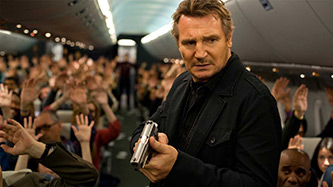According to the Director's Guild of America's website, the assistant director trainee program you participated in is "designed to provide opportunities for a limited number of individuals to become Assistant Directors," and comprises of "a rotation system [that] places trainees on the sets of various features, television series, and commercials."
So, Jack--what did you learn on the set of Liam Neeson's latest throat-punching action-thriller Non-Stop?
Your first lesson appears to have been on the finer points of establishing mood; specifically, the psychological mood of a former cop turned renegade air marshal (as they do). All the essentials are present in the opening scenes of the film: grimy close-ups of cigarettes being sucked and stubbed out, spastic hand-held shots during moments of calm (you know, because even when he's calm, he's on the edge!). It's also vital that you get the framing right when he reaches for his secret bottle of booze (always dark liquor; the clear stuff doesn't have the same despairing screen presence), and director Jaume Collet-Serra, as you no doubt observed, keeps things appropriately tight. He even had Neeson pause and stare at the bottle right before tipping it back. You know, because he's reluctant. They call this "complexity of character." You might be a few years away from directing actors - probably after you assist a few second-unit assistant directors - but it's important to pay attention to these small details.
I hope you were taking notes, too, when the action moves onto the plane. When trapped in such a relatively small space, most filmmakers might do the obvious thing and exaggerate that sense of claustrophobia with long lenses and high-contrast lighting. Maybe bring back a bit of that shaky-cam from earlier. But it takes some ambition to draw the camera outside the plane to pan across the exterior windows for a series of reaction shots from the passengers. It's even a bit daring to open up the space of the cabin with a free-floating camera that glides unobstructed over the tops of the seats. This jetliner, as a result, feels as wide open as a football field (an apt metaphor, don't you think?--what with all the tackling that ensues).
This operatic use of the camera is the most obvious clue that Non-Stop aspires to be, in style and substance, a Hitchcockian locked-room mystery. And the biggest surprise might be that it doesn't entirely fail. For a while, the plot uncoils with mechanical precision; a anonymous terrorist dictates that every twenty minutes a passenger will die. And so they do, mostly in clever ways. But with Liam Neeson in the lead, throats must be punched, daughters _must _be avenged. How to balance these two juggernauts of narrative energy? How to marry the action and the suspense?
The answer, in this case, is to flagellate your fun premise with a little bit of real-world socio-political commentary.
And here, Jack, is where you learned your biggest lesson on the set of Non-Stop: that there's nothing in our cultural memory so sacred that Hollywood can't exploit if for gain. Even if the gain is something as innocuous as the film's big reveal, when the real hijacker suddenly appears and does what all lame movie villains do: gives a speech that explains everything and means nothing.
But don't feel bad. You're still learning. Even the most seasoned assistant director could have done little to fix such a fundamental story flaw. I just hope you read the fine print on your internship agreement: "Acceptance into the program is not a guarantee of graduation." Remember what you learned while shooting the first 90 minutes out of 107. Forget everything else.
Sincerely,

Jared







